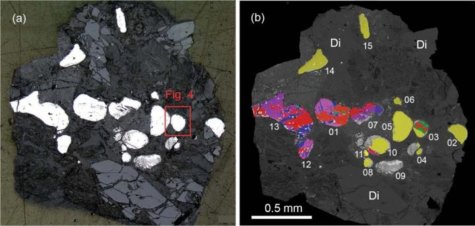ST. PETERSBURG, Russia — A rare mineral that scientists say has only been found inside meteorites has made its way to Earth. The discovery points to the possibility that this space rock may actually be a part of our world after all.
Nearly 20 years ago, researchers discovered a tiny iron meteorite in Yakutia, Russia, along the Onello riverbank. Scientists examined the space rock, called Onello, and found that it was comprised of a rare mineral they named allabogdanite. It’s a phosphide that includes both iron and nickel, giving it a metallic luster.
Since the discovery of allabogdanite, experts believed it only existed as part of asteroids and meteors out in space. However, researchers from St. Petersburg University recently found a sample of this mineral in a desert near the Dead Sea. The team was examining other phosphides in the sediment from that body of water when they encountered allabogdanite. It marks the first time the mineral has been discovered within Earth sediments.

“Our research included the experiments on phase transitions of terrestrial allabogdanite at high pressure and high temperature at the DESY synchrotron light source in Germany,” says study author and crystallography professor Sergey Britvin in a university release.
High pressure discovery
“It has been found that terrestrial allabogdanite could be formed at pressures exceeding 25 gigapascals that corresponds to 250 kbar. Such high pressures on Earth can be attained during catastrophic collisions with large meteorite impactors, or at the Earth’s mantle conditions, at a depth of more than 500 kilometers,” Britvin explains.
That amount of pressure is equivalent to 360,000 psi, which he explains could only be reached by space rock impacts or at depths of approximately 311 miles inside the mantle of Earth.
“However, the discovery of terrestrial allabogdanite is associated with the surface rocks of the Hatrurim Formation (also known as the Mottled Zone) in the Negev Desert in Israel. This is the area where natural cyclophosphates have been recently discovered,” the researcher continues.
Adding to this, Prof. Britvin says that the finding of this mineral in the South Levant area of the Middle East creates numerous concerns about the developmental circumstances of rocks found on the surface of sediment in this historic location, which he believes is significant.
So how did allabogdanite arrive on Earth?
Although scientists discovered allabogdanite in 2002, they only determined that it was a high-pressure substance in 2008. On Earth, it is in a “metastable high-pressure” state, meaning it can last for a long period of time so long as nothing disrupts its chemical balance. Study authors believe a similar mineral, barringerite, gave rise to allabogdanite, which could maintain its equilibrium on Earth due to quenching — the rapid reduction of a substance’s internal pressure and temperature.
“This way excludes the possibility of allabogdanite formation as an intermediate phase from the elements under atmospheric pressure. This, in turn, raises a number of key questions regarding the origin of rocks in the Mottled Zone,” Britvin explains.
“Until now, no evidence for the large meteorite collisions or the rocks having Earth’s mantle origin has been found in the South Levant. However, such evidence might have been erased from the Earth’s surface as a result of later processes of geological erosion. The discovery of allabogdanite justifies the necessity of further research in this direction.”
These findings appear in the journal American Mineralogist.
